
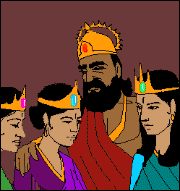 Dasharatha, the wise and just king of Ayodhya, had three
wives. The eldest queen, Kaushalya, had a son named Rama. The second queen,
Keikeyi, had a son named Bharata, and the youngest queen, Sumitra, had
two sons named Lakshmana and Shatrughna.
Dasharatha, the wise and just king of Ayodhya, had three
wives. The eldest queen, Kaushalya, had a son named Rama. The second queen,
Keikeyi, had a son named Bharata, and the youngest queen, Sumitra, had
two sons named Lakshmana and Shatrughna.
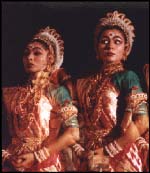 After ruling for many years, Dasharatha decided to retire and crown his
eldest son Rama, king of Ayodhya. However, a day before the coronation,
Keikeyi, instigated by her maid Manthara, asked the king to redeem two
boons he had promised her years ago. When Dasharatha consented, she asked
him to banish Rama to the forest for 14 years, and to make her own son,
Bharata, the king. Bound by his word, Dasharatha was forced to send Rama
on a 14-year exile. Rama's wife Sita and one of his brothers, Lakshmana,
decided to accompany him. Meanwhile, Dasharatha, unable to contain his
grief at having had to banish his favourite son, died.
After ruling for many years, Dasharatha decided to retire and crown his
eldest son Rama, king of Ayodhya. However, a day before the coronation,
Keikeyi, instigated by her maid Manthara, asked the king to redeem two
boons he had promised her years ago. When Dasharatha consented, she asked
him to banish Rama to the forest for 14 years, and to make her own son,
Bharata, the king. Bound by his word, Dasharatha was forced to send Rama
on a 14-year exile. Rama's wife Sita and one of his brothers, Lakshmana,
decided to accompany him. Meanwhile, Dasharatha, unable to contain his
grief at having had to banish his favourite son, died.
Bharata was away from Ayodhya when this happened.
On his return, when his mother told him what she had done, he was enraged.
He loved his brother and did not want to rule in his place.
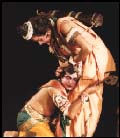
He set out in search of Rama and found him at the
entrance of the forest. However, no amount of persuasion would convince
Rama to return, for he believed he had to fulfil his dharma, by following
his father's instructions. He refused to return to Ayodhya until his exile
ended. Bharata returned to Ayodhya with Rama's slippers which he placed
on the throne as Rama's symbol and ruled as his brother's regent.
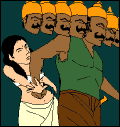 Rama, Sita and Lakshmana settled down to lead the life of ascetics in the
forest. There, Shoorpanakha, Ravana's sister, saw Rama and fell in love
with him. She tried to seduce him, without success. Believing that Sita
was the cause for Rama's inattention to her, Shoorpanakha attacked Sita.
Enraged, Lakshmana slashed off her nose and ears. Shoorpanakha then ran
to Ravana, to ask him to avenge her disgrace. She persuaded him to do so
by telling him about Sita's exceptional beauty. Ravana tricked Rama and
Lakshmana into leaving their hermitage. While Sita was alone, he abducted
her and took her to his kingdom. When Rama and Lakshmana returned, they
found her missing. During their search for her, they met Jatayu, the aged
eagle king. Jatayu had fought with Ravana to try and save Sita. He told
the princes what had happened, and they resolved to rescue her.
Rama, Sita and Lakshmana settled down to lead the life of ascetics in the
forest. There, Shoorpanakha, Ravana's sister, saw Rama and fell in love
with him. She tried to seduce him, without success. Believing that Sita
was the cause for Rama's inattention to her, Shoorpanakha attacked Sita.
Enraged, Lakshmana slashed off her nose and ears. Shoorpanakha then ran
to Ravana, to ask him to avenge her disgrace. She persuaded him to do so
by telling him about Sita's exceptional beauty. Ravana tricked Rama and
Lakshmana into leaving their hermitage. While Sita was alone, he abducted
her and took her to his kingdom. When Rama and Lakshmana returned, they
found her missing. During their search for her, they met Jatayu, the aged
eagle king. Jatayu had fought with Ravana to try and save Sita. He told
the princes what had happened, and they resolved to rescue her.
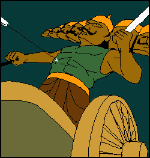 In this endeavour, they were assisted by an army of monkeys led by their
king, Sugriva. Hanuman, the son of Vayu and general of the monkeys, became
a devotee of Rama. The army crossed the sea to Lanka with Hanuman at the
helm and fought a hard battle. Rama defeated and killed Ravana and rescued
Sita.
In this endeavour, they were assisted by an army of monkeys led by their
king, Sugriva. Hanuman, the son of Vayu and general of the monkeys, became
a devotee of Rama. The army crossed the sea to Lanka with Hanuman at the
helm and fought a hard battle. Rama defeated and killed Ravana and rescued
Sita.
However, Rama was reluctant to accept Sita back,
because she had lived in the home of another man for almost a year. But
Sita proved her innocence by an ordeal of fire. Agni vouched for her chastity
and handed her, unscathed, to Rama, who now welcomed her back. As the 14-year
exile had also come to an end, Rama and Sita, along with Lakshmana, returned
to Ayodhya where Rama was crowned king.
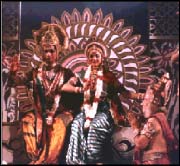 Rama and Sita lived happily for some time. Yet there were people in the
kingdom who were unhappy about the fact that their queen had lived in the
house of another man for so long. Rama, convinced that his queen had to
be above suspicion, banished a pregnant Sita from Ayodhya. She went to
live in Sage Valmiki's hermitage, where she gave birth to twin sons, Luv
and Kusha. The boys grew up in the hermitage and were educated by Valmiki.
When they were about 15 years old, they went to Ayodhya and encountered
Rama, who asked them about Sita. When he learnt that she was at the hermitage,
he went there to bring her back to Ayodhya. However, he said that for the
sake of his subjects, she would have to prove her innocence publicly, with
yet another trial by fire. Even Sita's enduring spirit could not bear this
final cruelty. She called upon her mother, the Earth, to prove her chastity
and take her back into her arms forever. Bhoodevi, the Earth, parted under
Sita's feet to accept her. As Sita was being swallowed by the Earth, Kusha
tried to save his mother but was unsuccessful. Heartbroken, Rama decided
to give up his life and took jala samadhi by walking into the Sarayu River.
Rama and Sita lived happily for some time. Yet there were people in the
kingdom who were unhappy about the fact that their queen had lived in the
house of another man for so long. Rama, convinced that his queen had to
be above suspicion, banished a pregnant Sita from Ayodhya. She went to
live in Sage Valmiki's hermitage, where she gave birth to twin sons, Luv
and Kusha. The boys grew up in the hermitage and were educated by Valmiki.
When they were about 15 years old, they went to Ayodhya and encountered
Rama, who asked them about Sita. When he learnt that she was at the hermitage,
he went there to bring her back to Ayodhya. However, he said that for the
sake of his subjects, she would have to prove her innocence publicly, with
yet another trial by fire. Even Sita's enduring spirit could not bear this
final cruelty. She called upon her mother, the Earth, to prove her chastity
and take her back into her arms forever. Bhoodevi, the Earth, parted under
Sita's feet to accept her. As Sita was being swallowed by the Earth, Kusha
tried to save his mother but was unsuccessful. Heartbroken, Rama decided
to give up his life and took jala samadhi by walking into the Sarayu River.
The epic is divided into seven sections, or kandas:
1. Bal Kanda, the boyhood section.
2. Ayodhya Kanda, the section at Ayodhya, including
the banishment of Rama.
3. Aranya Kanda, the forest section, including Rama's
life in the forest and Sita's abduction by Ravana.
4. Kishkindha Kanda, the section describing Rama's
stay at Kishkindha, the capital of his monkey ally, Sugriva.
5. Sundara Kanda, the beautiful section, including
the description of Rama's passage to Lanka and his arrival there.
6. Yuddha Kanda, the war section, describing the
war with Ravana, his death, the recovery of Sita, and the return to Ayodhya.
It is also known as the Lanka Kanda.
7. Uttara Kanda, the later section, including Rama's
life in Ayodhya as king, the banishment of Sita, the birth of her two sons,
Sita's test of innocence, her return to her mother, and Rama's jala samadhi.
This section was added after the main story had been written.
There are two popular versions of the Ramayana. One
is the Valmiki Ramayana, believed to have been composed and written by
Sage Valmiki. The other is Tulasidasa' version, called the Ramcharitmanas.
For centuries, the story existed only orally in Sanskrit. The Ramcharitmanas
was the first 'popular Ramayana' written in a dialect of Hindi, the language
of ordinary people.
With the spreading popularity of the Ramayana, other
versions of the epic, including one in Tamil in verse by a sage named Kanbar,
soon came about. Along with the Mahabharata, the story of Rama became the
inspiration for dance, song, and theatrical themes. Interestingly, many
regional versions of the Ramayana, most notably the Ramcharitmanas, do
not include the last section, the Uttara Khand. Of Tulasidasa, it is said
that he was such a devout follower of Rama that he could not accept his
idol having banished a pregnant wife to the forest. So he ended his version
of the story with Rama and Sita's return to Ayodhya.
